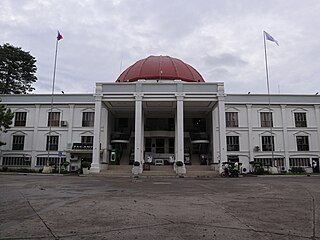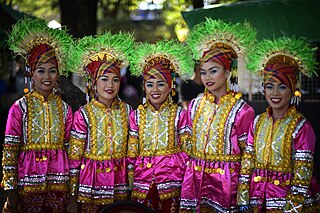
Mindanao (Jawi:مندنو) is the second-largest island in the Philippines, after Luzon, and seventh-most populous island in the world. Located in the southern region of the archipelago, the island is part of an island group of the same name that also includes its adjacent islands, notably the Sulu Archipelago. According to the 2020 census, Mindanao has a population of 26,252,442 people, while the entire island group has an estimated population of 27,021,036 according to the 2021 census.

Davao del Sur, officially the Province of Davao del Sur, is a province in the Philippines located in the Davao Region in Mindanao. Its capital is Digos. Davao City is the largest city in terms of area and population within the province's jurisdiction, yet it is administratively independent from the province; as such, Davao City is only grouped for geographical and statistical purposes.

Davao Oriental, officially the Province of Davao Oriental, is a province in the Philippines located in the Davao Region in Mindanao. Its capital is city of Mati, and it borders the province of Davao de Oro to the west, and Agusan del Sur and Surigao del Sur to the north. The province is the traditional homeland of the Mandaya and Kalagan/Kaagan.

South Cotabato, officially the Province of South Cotabato, is a province in the Philippines located in the Soccsksargen region in Mindanao. Its capital is Koronadal, and it borders Sultan Kudarat to the north and west, Sarangani to the south and northeast, and Davao del Sur to the far northeast. To the southeast lies Sarangani Bay.

Sarangani, officially the Province of Sarangani, is a province in the Philippines located in the Soccsksargen region. Its capital is Alabel. With a 230-kilometre (140 mi) coastline along the Sarangani Bay and Celebes Sea, the province is at the southernmost tip of Mindanao island, and borders South Cotabato and Davao del Sur to the north, Davao Occidental to the east, and the Celebes Sea to the south.

Cotabato or North Cotabato, officially the Province of Cotabato, is a landlocked province in the Philippines located in the Soccsksargen region in Mindanao. Its capital is the city of Kidapawan. Some of its barangays are under the jurisdiction of the nearby Bangsamoro Autonomous Region.

Digos, officially the City of Digos, is a 2nd class component city and capital of the province of Davao del Sur, Philippines. According to the 2020 census, it has a population of 188,376 people.

The Tboli people are an Austronesian ethnic group native to South Cotabato in southern Mindanao in the Philippines.

Malungon, officially the Municipality of Malungon, is a 1st class municipality in the province of Sarangani, Philippines. According to the 2020 census, it has a population of 105,465 people.

Lake Sebu, officially the Municipality of Lake Sebu, is a 1st class municipality in the province of South Cotabato, Philippines. According to the 2020 census, it has a population of 81,221 people.

Panabo, officially the City of Panabo, is a 3rd class component city in the province of Davao del Norte, Philippines. According to the 2020 census, it has a population of 209,230 people.

President Quirino, officially the Municipality of President Quirino, is a 3rd class municipality in the province of Sultan Kudarat, Philippines. According to the 2020 census, it has a population of 42,244 people. postal code 9804 president quirino.

Koronadal, officially the City of Koronadal, also known as Marbel, is a 3rd class component city and capital of the province of South Cotabato, Philippines. According to the 2020 census, it has a population of 195,398 people.

Kabacan officially the Municipality of Kabacan, is a 1st class municipality in the province of Cotabato, Philippines. According to the 2020 census, it has a population of 77,164 people.

Kidapawan, officially the City of Kidapawan, is a 3rd class component city and capital of the province of Cotabato, Philippines. According to the 2020 Census, it has a population of 160,791 people.

San Fernando, officially the Municipality of San Fernando, is a 1st class municipality in the province of Bukidnon, Philippines. According to the 2020 census, it has a population of 63,045 people.

TBoli, officially the Municipality of TBoli, is a 1st class municipality in the province of South Cotabato, Philippines. According to the 2020 census, it has a population of 101,049 people. The town is named after the indigenous natives themselves, the Tboli people.

Tnalak, is a weaving tradition of the Tboli people of South Cotabato, Philippines. T'nalak cloth is woven exclusively by women who have received the designs for the weave in their dreams, which they believe are a gift from Fu Dalu, the T'boli Goddess of abacá.
Blaan, also known as Bilaan, is an Austronesian language of the southern Philippines spoken by an indigenous ethnic group of the same name who inhabited many areas of Soccksargen and Davao Occidental.

The Teduray, also called Tiruray or Tirurai, are a Filipino ethnic group. They speak the Tiruray language. Their name may have come from words tew, meaning people, and duray, referring to a small bamboo hook and a line used for fishing.





















